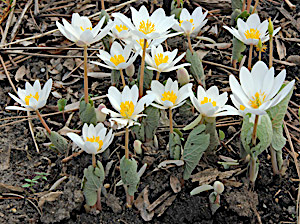Bloodroot
By William Kelleher, Fairfax Master Gardener Intern
 Bloodroot (Sanguinaria canadensis) is one of the earliest herbaceous perennials to emerge in the spring. It is found in rich woodlands with sandy to loamy soils in semi- to full-shaded conditions. This year, we found a profusion of bloodroot in mid-March growing along the paths in Haycock Longfellow Park, a small undeveloped Fairfax County park in McLean. The flower is the first sign of the plant to emerge from a single stem and a single leaf, and it blossoms only for a few days. Normally, the flower will open fully in the afternoon, based on the temperature, and then close as the temperature declines in the evening. It is about 6 inches tall and is barely able to get above the invasive euonymus which in this park provides a green groundcover all winter long. But on cool cloudy days, the flower may not open at all.
Bloodroot (Sanguinaria canadensis) is one of the earliest herbaceous perennials to emerge in the spring. It is found in rich woodlands with sandy to loamy soils in semi- to full-shaded conditions. This year, we found a profusion of bloodroot in mid-March growing along the paths in Haycock Longfellow Park, a small undeveloped Fairfax County park in McLean. The flower is the first sign of the plant to emerge from a single stem and a single leaf, and it blossoms only for a few days. Normally, the flower will open fully in the afternoon, based on the temperature, and then close as the temperature declines in the evening. It is about 6 inches tall and is barely able to get above the invasive euonymus which in this park provides a green groundcover all winter long. But on cool cloudy days, the flower may not open at all.

Bloodroot flower showing red/orange sap
S. canadensis has been a common native piedmont and coastal wildflower but it is increasingly “at risk” in the wild. It seems that collectors are harvesting the plants in the wild for personal gardens and even for sale. It is increasingly showing up in gardens where it is valued not only for its early spring flower but also for the interesting foliage that provides groundcover after the flower has blossomed.

Bloodroot with rhizome
In your garden, after the flower blooms, the interesting leaves come into their own and provide good groundcover until August, when it goes dormant. It may be getting harder to find bloodroot in the wild, but it is getting easier to find in cultivated gardens.
References
Native Plants for Northern Virginia, Virginia Native Plant Society
Sanguinaria canadensis, USDA Plant Database
Bloodroot: An Annotated Bibliography, Mary Predny and James Chamberlain, US Dept of Agriculture
Bloodroot (Sanguinaria canadensis), Virginia Tech Root Report